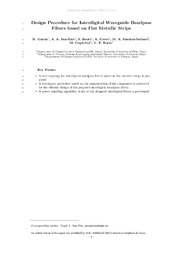Título :
Design Procedure for Interdigital Waveguide Bandpass
Filters based on Flat Metallic Strips |
Autor :
García, R.
San-Blas, Angel-Antonio 
Bonte, S.
Coves, A.
Sanchez-Soriano, A.
Guglielmi, M.
Boria, V.E. |
Editor :
American Geophysical Union |
Departamento:
Departamentos de la UMH::Ingeniería de Comunicaciones |
Fecha de publicación:
2025 |
URI :
https://hdl.handle.net/11000/36267 |
Resumen :
In this work, we describe a new topology for interdigital bandpass filters implemented in
waveguide technology. Compared to classical coaxial resonators, which are typically based on cylindrical
metallic posts, the resonators that we propose are based on rectangular boxed cavities loaded with flat metallic
strips of a finite thickness. The main advantages of the proposed topology are low‐cost practical realization and
manufacture simplicity. The design process, which is based on the classical circuit‐based approach combined
with an efficient segmentation of the component, uses the well‐known Aggressive Space Mapping technique,
with the aim of reducing the overall computation effort. In order to validate the new topology and the design
procedure, interdigital bandpass filters of orders 3 and 5 operating at the S‐band have been designed. For
validation purposes, the results obtained are successfully compared to simulations provided by two different
full‐wave electromagnetic tools (i.e., Ansys HFSS and CST Studio Suite). Furthermore, a multipactor study has
also been performed, with the aim of exploring the power handling capability of the proposed filters in view of
possible space applications. Finally, the design of classical interdigital filters based on cylindrical posts is also
discussed, with the aim of comparing both topologies regarding compactness, as well as in terms of their electrical and high‐power performance.
|
Área de conocimiento :
CDU: Ciencias aplicadas: Ingeniería. Tecnología |
Tipo de documento :
info:eu-repo/semantics/article |
Derechos de acceso:
info:eu-repo/semantics/openAccess
Attribution-NonCommercial-NoDerivatives 4.0 Internacional |
DOI :
10.1029/2024RS008195 |
Publicado en:
Radio Science, Volume 60, Issue 4
April 2025 |
Aparece en las colecciones:
Artículos Ingeniería Comunicaciones
|
 La licencia se describe como: Atribución-NonComercial-NoDerivada 4.0 Internacional.
La licencia se describe como: Atribución-NonComercial-NoDerivada 4.0 Internacional.
.png)
